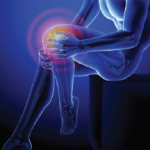“We’re still learning about who benefits from arthroscopic partial meniscectomy for a degenerative meniscus tear and who doesn’t,” Dr. Senter said. “But when you look at the literature broadly, it looks like most patients don’t benefit from arthroscopic meniscectomy for degenerative meniscus tears.”
She said it may be best to “think of a degenerative meniscus tear as part of the natural history of osteoarthritis. And so we tend to treat these patients as OA patients with a nonsurgical knee OA program to start.”
Indications for knee arthroscopy include an acute meniscus tear, a locked or locking knee, or a ligament tear.
Adhesive Capsulitis
When examining the shoulder, she said, the range of motion is the most crucial aspect. “The range of motion really helps me quickly triage what this patient has,” she said. “If the active range of motion is decreased, you really want to look at passive range of motion.”
If they’re both decreased, she said, the patient typically can only have arthritis of the glen humoral joint or adhesive capsulitis (i.e., frozen shoulder).
In frozen shoulder cases, an MRI doesn’t help, she said. “Adhesive capsulitis really is a clinical diagnosis,” she said. “Often an MRI will have findings in these patients who are most commonly age 40–60,” such as partial thickness rotator cuff tears, and the results could just bring confusion.
X-rays, meanwhile, can help to look at the glen humoral joint for arthritis.
Frozen shoulder can take two to three years to resolve, with a three- to nine-month freezing stage that hurts, a four- to 12-month frozen phase, with less pain but more stiffness, and a one- to three-year thawing stage of recovery. It usually resolves on its own.
Dr. Senter suggested diabetes screening in these patients. “One in five diabetics get a frozen shoulder,” she said. “It’s very common in diabetes.”
NSAIDs or steroid injections can manage pain, but they won’t alter the disease course, she said. Studies aren’t clear on whether physical therapy speeds recovery, but many patients seem to find it helpful, she said.
Doctors can recommend surgery in some cases, she said, but it’s fairly rare. “If a patient stays in the frozen stage up to a year, I tend to send those patients to our surgeon for arthroscopy. But the vast majority of patients really recover on their own.”
Fibrosing Lung Diseases
Sometimes the first sign of an autoimmune disease appears in the lung, said Paul Noble, MD, chair of pulmonary medicine at Cedars-Sinai Medical Center in Los Angeles. “I’ve seen patients I treated for what I thought was idiopathic pulmonary fibrosis … and their rheumatoid arthritis blossomed a decade later,” he said.


